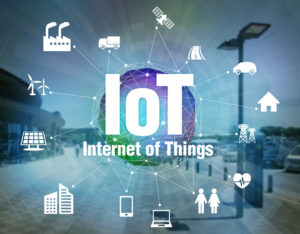
If you’re asking this question, you might feel like you’ve missed something. Don’t worry – many people ask this question. In fact, even technology experts may ask this question, since the Internet of Things (IoTThe Internet of Things. A broad term covering many different applications where "things" are interconnected through the internet.) is not very well defined.
The idea of the IoT comes from the fact that, over the last couple of decades, we as humans have become intensely more connected through the internet. OK, maybe we pay too much attention to the computer and weaken our immediate connections (hopefully not!), but we can now regularly interact with people almost anywhere on the globe.
This concept of people being connected has now moved from humans to machinesIn our context, a machine is anything that isn't human (or living). That includes electronic equipment like computers and phones.. As we’ll see, in industry, they’ve been working for years on connecting drill presses and pumps and all manner of equipment to the internet so they can keep better track of how things are going. Or they might have one piece of equipment talk to another. They’ve called this machine-to-machine (M2M) connectivityThis refers to some kind of electrical connection. It might be through a network cable, a cable connection, a wireless connection, or a phone - just to name some options. The connection might be to the internet or to some other local device..
Well, that notion of connecting equipment has been generalized to pretty much anything. You might be more familiar with Smart HomeA buzzword for interconnected home devices - TV, refrigerator, door locks, etc. devices – like Google’s Nest thermostat. Because all of these things may get an internet connection, the term “Internet of Things” was coined – and it stuck hard.
Connected to what?
The IoT connections we’re talking about are over networksA collection of items like computers, printers, phones, and other electronic items that are connected together by switches and routers. A network allows the connected devices to talk to each other electronically. The internet is an example of an extremely large network. Your home network, if you have one, is an example of a small local network., much like the WiFiA common type of wireless network used to connect computers and phones to each other and the internet. network you may have in your home. The connections may go to other devices, to your phone, or to a giant bank of computers far away. We’ll be talking about all these things.
Does every single thing need to be connected? Can you really make better toast with an internet-connected toaster? That’s not clear. And it’s a complicated question – and to some extent, the tech industry isn’t asking whether you want these things. It’s pushing them out, take it or leave it. Something else that we’ll look at.
That’s why you want to be sure you understand what’s going on – so you can make the best choices for yourself. There’s no one right answer for everyone. For example, a single person that travels a lot may benefit from being able to control their home from afar much more than someone who is mostly at home.
For now, jump on the ride here. As I get more and more content put up, I’ll add some navigation tools so you can go to the things you’re interested more easily. Also, if you get stuck on a term you’re not familiar with, it may be in the glossary. If it is, you should be able to see that and then mouse over the word for a definition. If you don’t find it there, let me know and I’ll add it.
And we’re off…

Leave a Reply